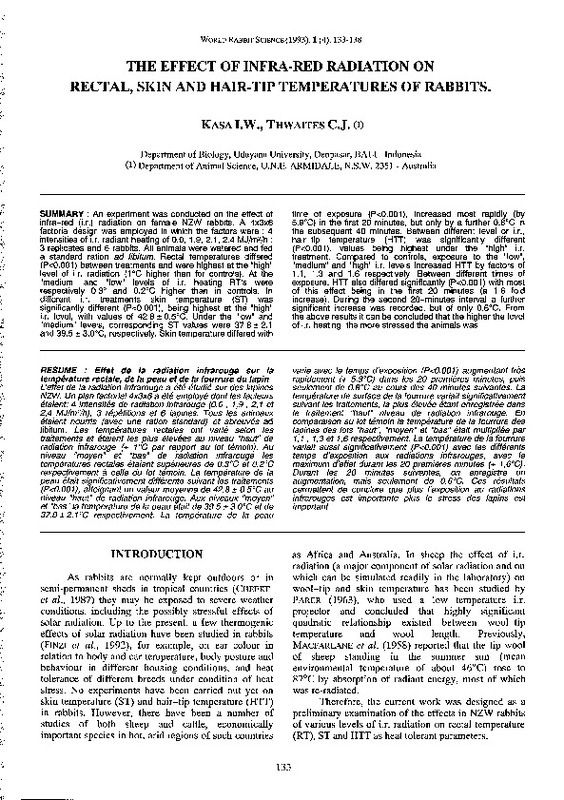JavaScript is disabled for your browser. Some features of this site may not work without it.
Buscar en RiuNet
Listar
Mi cuenta
Estadísticas
Ayuda RiuNet
Admin. UPV
THE EFFECT OF INFRA-RED RADIATION ON RECTAL, SKIN AND HAIR-TIP TEMPERATURES OF RABBITS
Mostrar el registro sencillo del ítem
Ficheros en el ítem
| dc.contributor.author | Kasa, I.W.
|
|
| dc.contributor.author | Thwaites, C.J.
|
|
| dc.date.accessioned | 2011-03-23T11:48:36Z | |
| dc.date.available | 2011-03-23T11:48:36Z | |
| dc.date.issued | 1993 | |
| dc.identifier.issn | 1257-5011 | |
| dc.identifier.uri | http://hdl.handle.net/10251/10554 | |
| dc.description.abstract | [EN] An experiment was conducted on the effect of infra-red (i.r.) radiation on female NZ>/11 rabbits. A 4x3x6 factorial design was employed in which the factors were : 4 intensities of i.r. radiant heating of O.O, 1.9, 2.1, 2.4 MJ/m2/h ; 3 replicates and 6 rabbits. All animals were watered and fed a standard ration ad libitum. Rectal temperaturas differed (P<0.001) between treatments and were highest at the "high" level of i.r. radiation (1 ºC higher than far controls). At the "medium" and "low" levels of i.r. heating RT's were respectively 0.3º and 0.2ºC higher than in controls. In different i.r. treatments skin temperatura (ST) was significantly different (P<0.001), being highest at the "high" i.r. level, with values of 42.8 ± 0.5ºC. Under the "low" and "medium" levels, corresponding ST values were 37.8 ± 2.1 and 39.5 ± 3.0ºC, respectively. Skin temperatura differed with time of exposure (P<0.001), increased most rapidly (by 5.9ºC) in the first 20 minutes, but only by a further 0.8ºC in the subsequent 40 minutes. Between different level or i.r., hair-tip temperatura (HTT) was significantly different (P<0.001), values being highest under the "high" i.r. treatment. Comparad to controls, exposure to the "low", "medium" and "high" i.r. levels increased HTT by factors of 1.1, 1.3 and 1.6 respectively. Between different times of exposure, HTT also differed significantly (P<0.001) with most of this effect being in the first 20 minutes (a 1.6 fold increase). During the second 20-minutes interval a further significant increase was recordad, but of only 0.6ºC. From the above results it can be concluded that the higher the level of i.r. heating, the more stressed the animals was. | es_ES |
| dc.description.abstract | [FR] L'effet de la radiation infrarouge a été étudié sur des tapines NZW. Un plan factoriel 4x3x6 a été employé dont les facteurs étaient: 4 intensités de radiation infrarouge (0,0, 1,9, 2, 1 et 2,4 MJ/m2/h), 3 répétitions et 6 tapines. Tous les animaux étaient nourris (avec une ration standard) et abreuvés ad libitum. Les températures rectales ont varié selon les traitements et étaient les plus élevées au niveau "haut" de radiation infrarouge (+ 1 ºC par rapport au lot témoin). Au niveau "moyen" et "bas" de radiation infrarouge les températures rectales étaient supérieures de 0.3ºC et 0.2ºC respectivement a ce/le du lot temoin. La température de la peau était significativement différente suivant les traitements (P<0.001), atteignant un valeur moyenne de 42.8 ± 0.5ºC au niveau "haut" de radiation infrarouqe. Aux niveaux "moyen" et "bas" la température de la peau etait de 39.5 ± 3.0ºC et de 37.8 ± 2. 1 ºC respectivement. La température de la peau varíe avec le temps d'exposition (P<0.001) augmentant tres rapidement (+ 5.9ºC) dans les 20 premieres minutes, puis seu/ement de 0.8ºC au cours des 40 minutes suivantes. La température de surface de la fourrure variait significativement suivant les traitements, la plus élevée étant enregistrée dans le traitement "haut" niveau de radiation infrarouge. En comparaison au lot témoin la température de la fourrure des tapines des lots "haut", "moyen" et "bas" était multipliée par 1, 1, 1,3 et 1,6 respectivement. La température de la fourrure variait aussi significativement (P<0.001) avec les différents temps d'exposition aux radiations infrarouges, avec le maximum d'effet durant les 20 premieres minutes (+ 1,6ºC). Durant les 20 minutes suivantes, on enregistre un augmentation, mais seulement de 0.6ºC. Ces résultats permettent de conclure que plus l'exposition au radiations infrarouges est importante plus le stress des lapins est importan t. | |
| dc.language | Inglés | es_ES |
| dc.publisher | World Rabbit Science. ICTA. UPV | es_ES |
| dc.relation.ispartof | World Rabbit Science | |
| dc.rights | Reserva de todos los derechos | es_ES |
| dc.title | THE EFFECT OF INFRA-RED RADIATION ON RECTAL, SKIN AND HAIR-TIP TEMPERATURES OF RABBITS | es_ES |
| dc.type | Artículo | es_ES |
| dc.date.updated | 2011-03-23T11:39:08Z | |
| dc.identifier.doi | 10.4995/wrs.1993.206 | |
| dc.rights.accessRights | Abierto | es_ES |
| dc.description.bibliographicCitation | Kasa, I.; Thwaites, C. (1993). THE EFFECT OF INFRA-RED RADIATION ON RECTAL, SKIN AND HAIR-TIP TEMPERATURES OF RABBITS. World Rabbit Science. 1(4). https://doi.org/10.4995/wrs.1993.206 | es_ES |
| dc.description.accrualMethod | SWORD | es_ES |
| dc.relation.publisherversion | https://doi.org/10.4995/wrs.1993.206 | |
| dc.description.volume | 1 | |
| dc.description.issue | 4 | |
| dc.identifier.eissn | 1989-8886 | es_ES |








